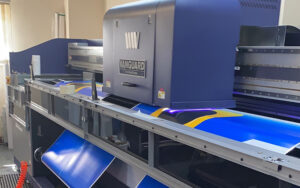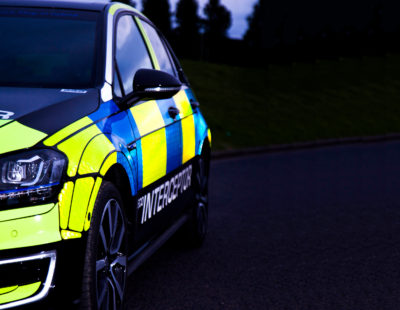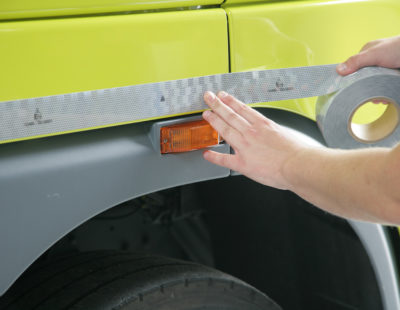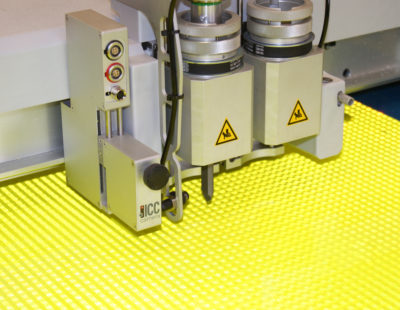When larger than normal vehicles take to the roads at night, they can present a hazard to other road users. Even at relatively close quarters, it can be hard to make out the contours of the vehicle just using headlights. To avoid severe accidents with HGVs, trailers, and even emergency vehicles, retroreflective tape is a road safety essential – and for certain vehicles, is required by law.
Lakeside Group is an established supplier of high quality reflective products. Committed to improving road safety at every turn, our Avery Dennison V6700B ECE 104 compliant conspicuity tape is the ultimate answer to night time conspicuity.
In this guide, we explain everything you need to know about reflective tape, including the relevant regulations.
What is reflective tape?
Reflective tape is an essential vehicle safety product. Also known as vehicle contour or conspicuity tape, it improves safety by making the edges of large vehicles more obvious to other road users, reducing the risk of accidents and their severity.
Retroreflective tape works by sending light directly back to its source, making it clearly visible, and is arranged so as to delineate the outline of the large object in question. Reflective tape can be air-celled or solid construction, with the latter proving the most durable, long-lasting option.
A Buyer’s Guide to Reflective Material for Vehicles >
Importance of reflective tape
Reflective tape is crucial to road safety, helping other drivers avoid large vehicles and identify them well in advance. Whether the vehicle in question has stopped to carry out highway maintenance, is changing lanes, or is an emergency vehicle rushing to the scene of an accident, reflective tape protects assets, keeps people safe, and saves money.
When visibility is reduced, there is a greater chance of serious accidents occurring on the road. At night, even the largest vehicles can be hard to make out if not properly illuminated. In typical conditions, low beam headlines have a 50m – 80m range, and high beams 100m – 150m. When you consider that a vehicle travelling at 60mph needs around 60m to come to a stop, the necessity of conspicuity products becomes clear.
Reflective tape applications
High quality reflective tape has a multitude of uses. Whilst it is most commonly used for the delineation of HGVs, trailers, and emergency vehicles, it is also commonly applied to PPE to protect the safety of those working on highways and in other areas of low visibility.
Reflective tape can also be used by cyclists, motorbike riders, and other vulnerable road users to increase their visibility. Some people also choose to use reflective tape on parts of a property that might be hard to make out. For example, around gateways and driveways to make any obstacles more easily discernible in the dark.
ECE 104 regulations explained
ECE 104 stands for regulation number 104 of the Economic Commission for Europe for the United Nations. It is the regulation that governs the use of retroreflective tape on heavy goods vehicles throughout Europe.
According to ECE 104, any vehicle over 7.5 tonnes manufactured after 2011, and any trailers over 3.5 tonnes, must have reflective tape applied to them. These reflective markings must outline the rear and sides of the vehicle, and be visible for up to 1000 metres in low light conditions.
Reflective tape comes in different grades, and the regulations state that a high quality, durable product must be used. It specifies Class C for white, yellow, and red markings, and Class D and E for HGV vehicle markings of any colour.
When it comes to positioning, there are also strict guidelines:
- – Rear of the vehicle – a complete contour marking box taking up at least 80% of the vehicle’s width needs to be applied if the rear of the vehicle is wider than 2100mm, and it should be as close as is practically possible to the edge.
- – Side of the vehicle – you can choose from two options: another complete contour marking box, or what are known as ‘corner ticks’, with the latter being the minimum requirement. These markings should also equal at least 80% of the length of the vehicle or trailer, and the length of upper corner tape must be at least 250mm.
High quality ECE 104 compliant reflective tape
At Lakeside Group, we’re passionate about the power of reflective products to enhance road safety for everyone. We supply our customers with high quality reflective tape from leading manufacturer Avery Dennison, helping vehicles stay highly visible even in the worst conditions.
We recommend solid construction contour tape, which far exceeds competing air-celled products in terms of durability and longevity, and ensures ECE 104 compliance. Our most popular tape is the Avery Dennison V6700B, which performs exceptionally well in all light conditions, and lasts for years to come.
To find out more about the reflective vehicle contour tapes we offer, contact our team today.




